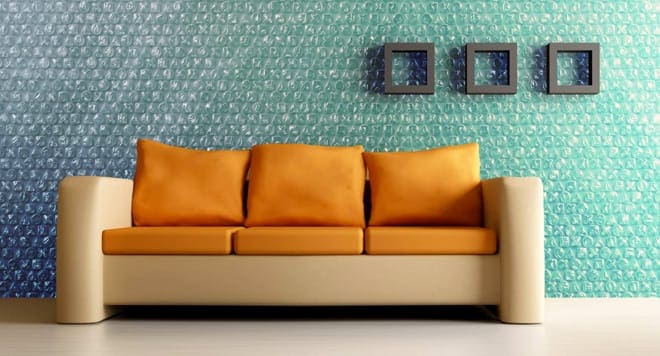The Amazing, Accidental History of Bubble Wrap
The invention of bubble wrap revolutionized the shipping process and helped launch today’s billion-dollar Ecommerce industry—but it was never intended to. As part 2 of our series celebrating National Bubble Wrap Appreciation Day this month, today we present you with the strange, surprising history of an iconic product that started life as a failed experiment.
Groovy Beginnings
In 1957, the Beat generation was just beginning to usher in an age of creative experimentation. Just like music and fashion, interior design was also getting a groovy new makeover. It wasn’t unusual to see walls outfitted in vibrant patterns and natural materials such as bamboo. It’s amidst this context that inventors Alfred Fielding and Marc Chavannes set out to create a unique, textured wallpaper out a popular modern material, plastic. (Although prototypical plastic had existed since the late 1800s, new chemical technologies in the ‘60’s led to an explosion in plastic manufacturing throughout the decade.)
After placing two pieces of plastic shower curtain through a heat-sealing machine, the two men were surprised by the results: a single sheet of film with air bubbles trapped inside. While the wallpaper idea would never take off, the inventors knew that their product could be used for something. The trick would lie in finding out what.
Patents & Patience
Fielding and Chavannes promptly filed six patents for the manufacturing process they had used to create “Air Cap,” as they called it, as well as the lamination equipment and materials. They then put their heads together to brainstorm a useful application for the material. Though they came up with over 400 ideas, only one—greenhouse insulation—ultimately made it off the drawing board. Unfortunately, the reaction from consumers was lukewarm. For the time being, Bubble Wrap remained a solution in search of a problem.
Big Break
As Fielding and Chavannes scratched their heads, up in Armonk, New York, a company called International Business Machines had just launched one of the world’s first mass-produced business computers. The delicate device, called the 1401, would need to be transported across the country without sustaining any damage. The preferred packaging material of the time—balled-up newspaper—wasn’t quite up to scratch. Bubble Wrap was the answer to IBM’s problem. It was cheap; it was clean (newspaper often left ink smudges on package contents); and it was adept at protecting the 1401’s fragile components. Once IBM—which, by 1960, was a powerful business entity—signed on, it seemed like only a matter of time until Bubble Wrap took off.
The Dunphy Era
As the ‘60s crept into the ‘70s, Bubble Wrap rose steadily in popularity and household usage. Despite this, though, and in spite of IBM’s seal of approval, Bubble Wrap still hadn’t turned a significant profit. Part of the problem lay in the interests of the company founders: Chavannes and Fielding were engineers, not businessmen, and both were much more interested in making inventions than in selling them.
It was T.J. Dermot Dunphy, who became CEO of Sealed Air in 1971, who helped turn Bubble Wrap and its sister products into money-making machines. An entrepreneur by training, Dunphy helped Sealed Air stabilize its operation and diversify its product base. For example, he was able to expand the brand into the swimming pool industry, popularizing Bubble Wrap pool covers that kept water beneath them warm. By the time he left the firm in 2000, Dunphy had successfully built Sealed Air’s sales up to $3 billion annually. And Bubble Wrap had become a name so ubiquitous, most of today’s consumers aren’t even aware that it’s a brand.
Bubble Wrap Today
Today, Sealed Air has relocated to Charlotte, North Carolina, and devotes most of its business to food product packaging. But even though Bubble Wrap provides less than 10% of Sealed Air’s revenue, that hasn’t stopped company leadership from considering a name change. “’Sealed Air’ does lack a bit of marketing pizazz,” company CEO Bill Hickey told Forbesin 2012. A name like “Bubble Wrap, Inc.” would no doubt bring instant name recognition. Naming aside, there’s no doubt that Bubble Wrap is here to stay. It has also become a staple of modern society, repurposed as everything from wedding dresses to therapeutic treatment tools. Sadly, though, no one has tried using it for its first intended purpose, wallpaper—at least to our knowledge.
Order Bubble Wrap for Richmond, VA | Richmond Business Packaging Materials
Looking for bubble wrap or any other packaging material in Richmond, VA? Stop by SSI Packaging today! In addition to bubble wrap, we offer a wide range of packaging and shipping materials to keep your products safe. Feel free to stop by and see us, or check out our product inventory online.

